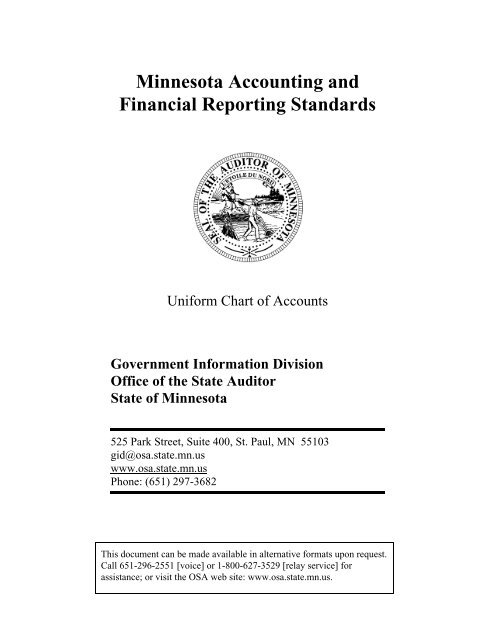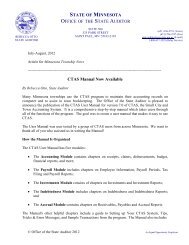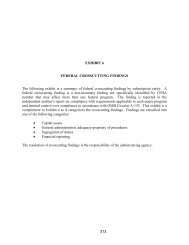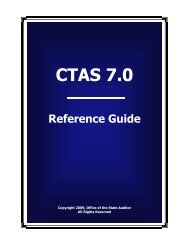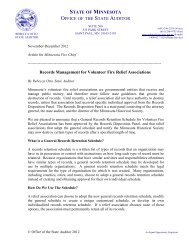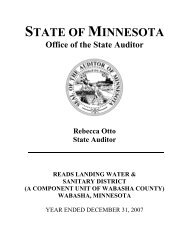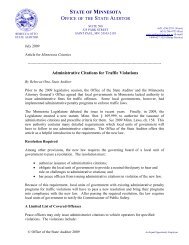Minnesota Accounting and Financial Reporting Standards - Uniform ...
Minnesota Accounting and Financial Reporting Standards - Uniform ...
Minnesota Accounting and Financial Reporting Standards - Uniform ...
Create successful ePaper yourself
Turn your PDF publications into a flip-book with our unique Google optimized e-Paper software.
<strong>Minnesota</strong> <strong>Accounting</strong> <strong>and</strong><strong>Financial</strong> <strong>Reporting</strong> St<strong>and</strong>ards<strong>Uniform</strong> Chart of AccountsGovernment Information DivisionOffice of the State AuditorState of <strong>Minnesota</strong>525 Park Street, Suite 400, St. Paul, MN 55103gid@osa.state.mn.uswww.osa.state.mn.usPhone: (651) 297-3682This document can be made available in alternative formats upon request.Call 651-296-2551 [voice] or 1-800-627-3529 [relay service] forassistance; or visit the OSA web site: www.osa.state.mn.us.
This page left blank intentionally
<strong>Minnesota</strong> City <strong>and</strong> Town <strong>Accounting</strong> <strong>and</strong> <strong>Financial</strong> <strong>Reporting</strong> St<strong>and</strong>ards<strong>Uniform</strong> Chart of AccountsIntroductionThis <strong>Uniform</strong> Chart of Accounts is designed for towns in <strong>Minnesota</strong>. The primary objective of a<strong>Uniform</strong> Chart of Accounts is to facilitate the preparation of uniform annual financial statements,that is, statements that may be reliably compared to those of other towns. Because of this aim, itis especially important that transactions are entered in a consistent manner. The <strong>Uniform</strong> Chartof Accounts is not a source of authority for towns to enter into agreements or to maketransactions. Rather, it describes the accounting for transactions authorized by law.The design of this <strong>Uniform</strong> Chart of Accounts is closely tailored to the 2001 GAAFR(Governmental <strong>Accounting</strong>, Auditing, <strong>and</strong> <strong>Financial</strong> <strong>Reporting</strong>) of the Government FinanceOfficers Association.Although a <strong>Uniform</strong> Chart of Accounts implies a uniform account numbering system for alltowns, it is the structure, rather than the numbers that is important. Towns with a largeinvestment in a different chart of accounts need not adopt the account numbers presented herein,provided those systems can be modified to present uniformly classified information.We further recommend that the <strong>Uniform</strong> Chart of Accounts be adopted when a town changesfrom a manual to a computer based accounting system or modifies an existing computer basedsystem. In addition, towns using the Small City <strong>and</strong> Town <strong>Accounting</strong> System (CTAS) mustfollow the chart of accounts. Corrections, recommendations, or additions to the uniform chart ofaccounts can be emailed to the Office of the State Auditor at gid@auditor.state.mn.us.Account StructureThe basic account structure has three dimensions: fund, account, <strong>and</strong> object code. Three digitsare assigned to the fund, five to the account, <strong>and</strong> three to the object code. Where required,cities/towns may exp<strong>and</strong> the number of dimensions <strong>and</strong>/or the number of digits assigned to adimension.The basic structure in the <strong>Uniform</strong> Chart of Accounts, then, is as follows:FUND ACCOUNT OBJECTAssets xxx 1xxxxLiabilities <strong>and</strong>Fund Equity xxx 2xxxxRevenues xxx 3xxxxExpenditures xxx 4xxxx xxx<strong>Minnesota</strong> Office of the State Auditor -1-
<strong>Minnesota</strong> City <strong>and</strong> Town <strong>Accounting</strong> <strong>and</strong> <strong>Financial</strong> <strong>Reporting</strong> St<strong>and</strong>ards<strong>Uniform</strong> Chart of AccountsFUNDSIntroductionThis section of the chart of accounts covers the various types of funds <strong>and</strong> examples of fundsmost appropriate for cities <strong>and</strong> towns in <strong>Minnesota</strong>.A fund is defined as a fiscal <strong>and</strong> accounting entity with a self-balancing set of accounts to recordcash <strong>and</strong> other resources, together with related liabilities <strong>and</strong> balances. Funds are segregated forthe purpose of carrying on specific activities or objectives under special regulations, restrictionsor limitations.It is recommended that separate funds be created only where necessary for operational or legalrequirements. Too many funds cause unnecessary complexity.Funds are grouped into three categories under the GAAFR restatement principles:1. Governmental Funds are those types of funds through which most governmentalfunctions are typically financed. The governmental types of funds are:Fund TypeFund Number‣ General Fund 100‣ Special Revenue Funds 200 - 299‣ Debt Service Funds 300 - 399‣ Capital Projects Funds 400 - 499‣ Permanent Funds 500 - 599‣ Governmental Activities 900 - 9992. Proprietary Funds are used to account for a government's organizations <strong>and</strong> activitiesthat are similar to the private sector. There are two types of proprietary funds:Fund TypeFund Number‣ Enterprise Funds 600 - 699‣ Internal Service Funds 700 - 7993. Fiduciary Funds are trust <strong>and</strong> agency funds used to account for assets held by agovernmental unit in a trustee capacity or as an agent. Fiduciary funds cannot be used tosupport the government’s own programs. The fund numbers are 800 – 899.<strong>Minnesota</strong> Office of the State Auditor -2-
<strong>Minnesota</strong> City <strong>and</strong> Town <strong>Accounting</strong> <strong>and</strong> <strong>Financial</strong> <strong>Reporting</strong> St<strong>and</strong>ards<strong>Uniform</strong> Chart of AccountsFund DefinitionsThe following types of funds <strong>and</strong> account groups should be used by local governments:GOVERNMENTAL FUNDSThe General Fund - to account for all financial resources except those accountedfor in another fund. It is the main operating fund of the government.Special Revenue Funds - to account for revenues derived from specific revenuesources that are legally restricted for specific purposes.Debt Service Funds - to account for the accumulation of resources for, <strong>and</strong> thepayment of, general long-term debt principal <strong>and</strong> interest.Capital Projects Funds - to account for financial resources to be used for theacquisition or construction of major capital facilities.Permanent Funds – to account for resources that are legally restricted to theextent that only earnings, <strong>and</strong> not principal, may be used for purposes that supportthe reporting government’s programs.Governmental Activities (government-wide financial reporting) – to accountfor balances related to governmental funds that are only reported in thegovernment-wide statements of net assets.PROPRIETARY FUNDSEnterprise Funds - to account for operations that are financed <strong>and</strong> operated in amanner similar to private business enterprises. A government’s business-typeactivities.Internal Service Funds - to account for the financing of goods <strong>and</strong> servicesprovided by one department to other departments of the town on a costreimbursementbasis.FIDUCIARY FUNDSTrust <strong>and</strong> Agency Funds - to account for assets held by a town in a trusteecapacity or as an agent for individuals, organizations, or other governments, orother funds.<strong>Minnesota</strong> Office of the State Auditor -3-
<strong>Minnesota</strong> City <strong>and</strong> Town <strong>Accounting</strong> <strong>and</strong> <strong>Financial</strong> <strong>Reporting</strong> St<strong>and</strong>ards<strong>Uniform</strong> Chart of AccountsCities <strong>and</strong> towns should use the following types of funds where applicable. Fund names areshown for illustrative purposes <strong>and</strong> are not intended to be an exhaustive list for cities <strong>and</strong> towns.FUND NAMESGOVERNMENTAL FUNDSGeneral Fund (100)100 General FundSpecial Revenue Funds (201 through 299)201 Road <strong>and</strong> Bridge ( recommended for towns)225 Fire225-299 OtherDebt Service Funds (301 through 399)301-350 General Debt Service (Identify)Capital Projects Funds (401 through 499)PROPRIETARY FUNDS401-450 General Capital ProjectsEnterprise Funds (601 through 699)601 Water602 Sewage Collection <strong>and</strong> Disposal603 Refuse or Garbage Collection651-699 Other<strong>Minnesota</strong> Office of the State Auditor -4-
<strong>Minnesota</strong> City <strong>and</strong> Town <strong>Accounting</strong> <strong>and</strong> <strong>Financial</strong> <strong>Reporting</strong> St<strong>and</strong>ards<strong>Uniform</strong> Chart of AccountsRevenues <strong>and</strong> Other Financing SourcesIntroductionIn governmental funds, the primary classification of governmental fund revenues is by fund <strong>and</strong>source. Major revenue source classifications are taxes, licenses <strong>and</strong> permits, intergovernmentalrevenues, charges for services, fines <strong>and</strong> forfeits, special assessments, <strong>and</strong> miscellaneous. Therevenue account (source code) is used to identify the source of the revenues.REVENUESTAXES31000 General Property Taxes. General Property Taxes are taxes levied on anassessed valuation of real <strong>and</strong>/or personal property by the town government.31700 Taxes Imposed <strong>and</strong> Apportioned by the Counties.31701 Gravel Tax. A percentage is credited to towns to be expended formaintenance <strong>and</strong> construction of roads <strong>and</strong> bridges.31800 Other Taxes. Other tax revenues not enumerated elsewhere.31810 Franchise Taxes. Proceeds from taxes imposed on public utilities by thetown other than property taxes.31900 Penalties <strong>and</strong> Interest on Delinquent Taxes. Penalties collected for latepayment of taxes.LICENSES AND PERMITS31910 Penalties <strong>and</strong> Interest on Ad valorem Taxes. Amounts received in cashas interest or penalties for failure to pay ad valorem taxes on time.31920 Forfeited Tax Sale Apportionments. Revenue received from taxforfeiture sales.32000 LICENSES AND PERMITS. Revenues received from the sale of business <strong>and</strong>non-business licenses.<strong>Minnesota</strong> Office of the State Auditor -5-
<strong>Minnesota</strong> City <strong>and</strong> Town <strong>Accounting</strong> <strong>and</strong> <strong>Financial</strong> <strong>Reporting</strong> St<strong>and</strong>ards<strong>Uniform</strong> Chart of Accounts32100 Business Licenses <strong>and</strong> Permits. Revenues from license sales tobusinesses <strong>and</strong> occupations, which must be licensed before doing businesswithin the town.32200 Non-Business Licenses <strong>and</strong> Permits. Revenues from all non-businesslicenses <strong>and</strong> permits levied according to benefits presumably conferred bythe license or permit.INTERGOVERNMENTAL REVENUES33000 INTERGOVERNMENTAL REVENUES. Revenues from other governmentsin the form of grants, entitlements or shared revenues. Does not include chargesfor services provided by a town fund to another government.33100 Federal Grants <strong>and</strong> Aids.33400 State Grants <strong>and</strong> Aids.33401 Local Government Aid.33405 Taconite Production Tax.33406 Taconite Homestead Credit.33407 Taconite Mobile Home Homestead Credit.33408 Taconite Municipal Aid.33418 Highway Use Tax. (Gas Tax)33425 Residential Market Value Credit.33426 Agricultural Market Value Credit.33427 Manufactured Home Market Value Credit.33428 State – Payments in Lieu of Taxes.33430 Other State Grants <strong>and</strong> Aids. (Identify)33600 Grants <strong>and</strong> Aids From Local Governmental Units.<strong>Minnesota</strong> Office of the State Auditor -6-
<strong>Minnesota</strong> City <strong>and</strong> Town <strong>Accounting</strong> <strong>and</strong> <strong>Financial</strong> <strong>Reporting</strong> St<strong>and</strong>ards<strong>Uniform</strong> Chart of AccountsCHARGES FOR SERVICES33610 County Grants <strong>and</strong> Aids for Highways.33620 Other County Grants <strong>and</strong> Aids. (Identify)33630-33699 Grants <strong>and</strong> Aids From Other Local Governments.34000 CHARGES FOR SERVICES. Charges for services should be segregated according tofunction <strong>and</strong> activity in the accounts indicated below.34100 General Government.34102 Filing Fees. Amounts received from persons filing for election.34200 Public Safety. Revenues for services rendered by police, fire <strong>and</strong> otherpublic safety departments.34201 Police Services.34202 Fire Protection Services.34205 Ambulance Revenues.34300 Highways <strong>and</strong> Streets. (Road <strong>and</strong> Bridges) Revenues from sales orcharges rendered by the town street department.34700 Culture - Recreation. Revenue received by the town for use of culturalor recreational facilities or from participation in programs run by the town.34900 Other Charges.34940 Cemetery Revenues.34950 Other. (Identify) Charges for services not classified elsewhere.35000 FINES AND FORFEITS.35100 Fines. Fines are receipts from penalties imposed for violation of laws orregulations, or neglect of duty.<strong>Minnesota</strong> Office of the State Auditor -7-
<strong>Minnesota</strong> City <strong>and</strong> Town <strong>Accounting</strong> <strong>and</strong> <strong>Financial</strong> <strong>Reporting</strong> St<strong>and</strong>ards<strong>Uniform</strong> Chart of AccountsSPECIAL ASSESSMENTS35200 Forfeits. Revenue derived from confiscated deposits or collection bondsor other surety held by the town for the enforcement of contracts or assecurity against loss or damage.36100 SPECIAL ASSESSMENTS. Revenues received from a compulsory levy onselected properties to defray part or all of the cost of a specific improvement orservice deemed to primarily benefit those properties. Revenues received shouldbe classified into the following two accounts, as a minimum:36101 Principal.MISCELLANEOUS REVENUES36102 Penalties <strong>and</strong> Interest.36200 MISCELLANEOUS REVENUES. Revenues not properly classified as taxes,licenses <strong>and</strong> permits, intergovernmental revenues, charges for services, or fines<strong>and</strong> forfeits.36210 Interest Earnings. Revenue received as interest on investments,including such investments as savings accounts, Certificates of Deposit,Money Market Funds <strong>and</strong> Treasury Bonds <strong>and</strong> Bills.36220 Rents <strong>and</strong> Royalties. Revenues received from rental of town properties,excluding town hall <strong>and</strong> community hall rent, parking lot fees, <strong>and</strong>auditorium use fees, which are classified elsewhere.36230 Contributions <strong>and</strong> Donations from Private Sources. Amounts receivedas donations from private agencies or persons.36240 Refunds <strong>and</strong> Reimbursements.36290 Sale of Investments. Proceeds received from the sale of investments.39200 Interfund Transfers In. Legally authorized transfers between fundsreceiving revenue to the funds through which the resources are to beexpended. Example: transfers from the General Fund to the Road <strong>and</strong>Bridge Fund.<strong>Minnesota</strong> Office of the State Auditor -8-
<strong>Minnesota</strong> City <strong>and</strong> Town <strong>Accounting</strong> <strong>and</strong> <strong>Financial</strong> <strong>Reporting</strong> St<strong>and</strong>ards<strong>Uniform</strong> Chart of AccountsEXPENDITURES/EXPENSES AND OTHER FINANCING USESIntroductionGovernmental expenditures are to be classified according to character, function (or program),activity <strong>and</strong> object. The expenditure accounts provide the classification by function <strong>and</strong> activity,<strong>and</strong> the object code provides the character <strong>and</strong> object classification.EXPENDITURESGENERAL GOVERNMENT41000 GENERAL GOVERNMENT. In expenditures, General Government represents a set ofaccounts to which are charged the expenditures for running the town government.41100 Legislative (Town Board). Expenditures by the Town Board (Supervisors).41300 Executive. Town Manager.41400 Town Clerk. Expenditures by the office of the town clerk. Such expendituresshould be sub-classified according to major activities performed by the clerk.41410 Elections.41500 <strong>Financial</strong> Administration. Expenditures of staff agencies performing financialmanagement <strong>and</strong> administrative functions for the town government.41510 Treasurer.41540 Auditing.41550 Assessing.41600 Legal Services. Town Attorney.41900 Other General Government.41940 Town Hall. Expenditures for the purchase <strong>and</strong> maintenance of the townhall.<strong>Minnesota</strong> Office of the State Auditor -9-
<strong>Minnesota</strong> City <strong>and</strong> Town <strong>Accounting</strong> <strong>and</strong> <strong>Financial</strong> <strong>Reporting</strong> St<strong>and</strong>ards<strong>Uniform</strong> Chart of Accounts42000 PUBLIC SAFETY. The objective of Public Safety is the protection of persons<strong>and</strong> property. All accounts within this group are directly related to that objective.PUBLIC WORKS42100 Police.42153 Ambulance Services. Expenditures for emergency ambulance servicesprovided directly or as a contractual service.42200 Fire42800 Other Protection.43000 PUBLIC WORKS. Public Works has two major sub-classifications: 1)Highways, Streets <strong>and</strong> Roadways <strong>and</strong> 2) Sanitation.43100 Highways, Streets <strong>and</strong> Roadways. This group of accounts is used torecord expenditures for the construction <strong>and</strong> maintenance of roadways.Expenditures for roadways <strong>and</strong> walkways in parks are not charged to theseaccounts, but to the appropriate accounts under culture-recreation.43121 Paved Streets. Expenditures for construction, maintenance <strong>and</strong>repair of street surfaces, curbs <strong>and</strong> gutters which are paved withasphalt, concrete, brick or stone.43122 Unpaved Streets. Expenditures incurred for the construction,maintenance <strong>and</strong> repair of unpaved streets, including grading,graveling, oiling, etc.43125 Ice <strong>and</strong> Snow Removal. Expenditures for removing ice <strong>and</strong> snow<strong>and</strong> for s<strong>and</strong>ing <strong>and</strong> salting streets, sidewalks, alleys <strong>and</strong> bridges.Includes expenditures for equipment specifically designed orintended for ice <strong>and</strong> snow removal.43126 Road <strong>and</strong> Bridge Equipment. Expenditures for road <strong>and</strong> bridgeequipment such as road graders <strong>and</strong> maintenance trucks.43130 Bridges, Viaducts <strong>and</strong> Grade Separations. Expenditures for theconstruction, maintenance <strong>and</strong> repair of bridges, viaducts, gradeseparations, trestles <strong>and</strong> railroad crossings.<strong>Minnesota</strong> Office of the State Auditor -10-
<strong>Minnesota</strong> City <strong>and</strong> Town <strong>Accounting</strong> <strong>and</strong> <strong>Financial</strong> <strong>Reporting</strong> St<strong>and</strong>ards<strong>Uniform</strong> Chart of Accounts43160 Street Lighting. Expenditures for street lighting fixtures <strong>and</strong> forlighting all bridges, alleys <strong>and</strong> streets, except those located inparks.43170 Street Cleaning.43200 Sanitation. This group of accounts is used to record expenditures for theremoval of solid waste <strong>and</strong> other types of waste material.43230 Waste (Refuse) Collection. Expenditures incurred for thecollection of garbage <strong>and</strong> other refuse <strong>and</strong> delivering it to the placeof disposal.43240 Waste (Refuse) Disposal. Expenditures incurred for the disposalof garbage <strong>and</strong> other refuse.43260 Weed Control. Expenditures for cutting <strong>and</strong> removing weeds fromgovernment property such as parkways <strong>and</strong> alleys <strong>and</strong> from privateproperty where such is not done by the property owners.CULTURE AND RECREATION45000 CULTURE-RECREATION. This group of accounts is used to record allexpenditures for cultural <strong>and</strong> recreational activities maintained by the town for thebenefit of residents <strong>and</strong> visitors.45100 Recreation.45200 Parks. Expenditures for public parks, public squares similar areas.Excludes ground surrounding public buildings, l<strong>and</strong> areas encompassed inother recreational facilities <strong>and</strong> maintenance of areas classified elsewhereunder culture-recreation.45509 Branch Libraries. Expenditures for the construction, maintenance <strong>and</strong>operation of branch libraries that are located away from the central library.CONSERVATION OF NATURAL RESOURCES.46100 CONSERVATION OF NATURAL RESOURCES. All expenditures for theconservation <strong>and</strong> development of natural resources.<strong>Minnesota</strong> Office of the State Auditor -11-
<strong>Minnesota</strong> City <strong>and</strong> Town <strong>Accounting</strong> <strong>and</strong> <strong>Financial</strong> <strong>Reporting</strong> St<strong>and</strong>ards<strong>Uniform</strong> Chart of AccountsDEBT SERVICE47000 DEBT SERVICE. Expenditures for debt service should be sub-classified by thetype of debt (bonds, other long-term obligations <strong>and</strong> short-term debt) <strong>and</strong> betweenprincipal <strong>and</strong> interest payments, through the use of the object code.MISCELLANEOUS.49000 MISCELLANEOUS. This group of accounts is charged with expenditures,which cannot properly be classified under or allocated to the foregoing functions<strong>and</strong> activities.49010 Cemetery. Expenditures for maintaining the town owned cemetery.49100 Judgments <strong>and</strong> Losses. Expenditures in settlement of claims against thetown for injury to persons or property. Does not include the cost of l<strong>and</strong>acquired by condemnation proceedings or the settlement of damage claimsresulting from construction projects.49200 Unallocated Expenditures. Expenditures by the town for variouspurposes, which cannot be allocated to specific functions <strong>and</strong> activities.Such unallocated expenditures should comprise a small minority, ratherthan a majority, of these expenditures.49350 Purchase of Investments. Payment amounts for the purchase ofinvestments.49360 Interfund Transfer Out. <strong>Financial</strong> outflows to other funds of the townthat are not classified as interfund services provided <strong>and</strong> used,reimbursements of loans.<strong>Minnesota</strong> Office of the State Auditor -12-
<strong>Minnesota</strong> City <strong>and</strong> Town <strong>Accounting</strong> <strong>and</strong> <strong>Financial</strong> <strong>Reporting</strong> St<strong>and</strong>ards<strong>Uniform</strong> Chart of AccountsEXPENDITURE OBJECT CODESIntroductionIn addition to the function/activity classification, expenditures should be classified according toobject class. The object indicates the type of item purchased or service obtained.The classifications by object class are:• Personal Services. Include expenditures for salaries, wages, <strong>and</strong> relatedemployee benefits provided for all persons employed by the town.Employee benefits include employer contributions to a retirement system,insurance, sick leave, severance pay, <strong>and</strong> similar benefits.• Supplies. Include articles <strong>and</strong> commodities that are consumed ormaterially altered when used, such as office supplies, operating supplies,repair <strong>and</strong> maintenance supplies, <strong>and</strong> small tools <strong>and</strong> minor equipment.• Services <strong>and</strong> Charges. Include expenditures for services other thanpersonal services. Examples of such changes include professionalservices, communication, transportation, advertising, printing <strong>and</strong> binding,insurance, utility services, repair <strong>and</strong> maintenance, rentals, <strong>and</strong>depreciation.• Capital Outlays. Include expenditures that result in the acquisition of oradditions to fixed assets.• Debt Service Expenditures. These expenditures are in the form of debtprincipal payments, periodic interest payments, <strong>and</strong> related service chargesthat benefit prior fiscal periods, as well as in current <strong>and</strong> future fiscalperiods• Other Financing Uses.<strong>Minnesota</strong> Office of the State Auditor -13-
<strong>Minnesota</strong> City <strong>and</strong> Town <strong>Accounting</strong> <strong>and</strong> <strong>Financial</strong> <strong>Reporting</strong> St<strong>and</strong>ards<strong>Uniform</strong> Chart of AccountsOBJECT CODESCURRENT EXPENSEPersonal Services100 Wages <strong>and</strong> Salaries115 Federal Income Taxes120 State Income Taxes121 PERA Contributions122 FICA Contributions125 Defined Contribution Plan (P.E.R.A.)126 Medicare Contributions130 Employer Paid Insurance140 Unemployment Compensation150 Worker' s Compensation160 Liability Insurance for EmployeesSupplies200 Office Supplies210 Operating Supplies212 Motor Fuels213 Lubricants <strong>and</strong> Additives220 Repair <strong>and</strong> Maintenance Supplies221 Equipment Parts<strong>Minnesota</strong> Office of the State Auditor -14-
<strong>Minnesota</strong> City <strong>and</strong> Town <strong>Accounting</strong> <strong>and</strong> <strong>Financial</strong> <strong>Reporting</strong> St<strong>and</strong>ards<strong>Uniform</strong> Chart of Accounts222 Tires for Equipment224 Street Maintenance Materials (Gravel)225 Street Maintenance Materials (Culverts)226 Signs/Repair240 Small Tools <strong>and</strong> Minor Equipment250 Merch<strong>and</strong>ise for ResaleServices <strong>and</strong> Charges300 Professional Services301 Auditing <strong>and</strong> <strong>Accounting</strong> Services304 Legal Fees310 Training320 Telephone331 Mileage340 Advertising350 Printing <strong>and</strong> Binding351 Legal Notices Publishing360 Insurance380 Utility Services384 Refuse Disposal400 Repairs <strong>and</strong> Maintenance--Contractual<strong>Minnesota</strong> Office of the State Auditor -15-
<strong>Minnesota</strong> City <strong>and</strong> Town <strong>Accounting</strong> <strong>and</strong> <strong>Financial</strong> <strong>Reporting</strong> St<strong>and</strong>ards<strong>Uniform</strong> Chart of Accounts410 Rentals420 Depreciation430 Miscellaneous433 Dues <strong>and</strong> Subscriptions435 Bank Service Charges436490 Donations to Civic Organizations (B<strong>and</strong>s, etc.)Capital Outlay510 L<strong>and</strong>520 Buildings <strong>and</strong> Structures530 Improvements Other Than Buildings540 Heavy Machinery550 Motor Vehicles560 Furniture <strong>and</strong> Fixtures570 Office Equipment <strong>and</strong> Furnishings580 Other Equipment590 Books599 Leasehold ImprovementsDebt Service600 Principal610 Interest620 Fiscal Agents' Fees<strong>Minnesota</strong> Office of the State Auditor -16-
<strong>Minnesota</strong> City <strong>and</strong> Town <strong>Accounting</strong> <strong>and</strong> <strong>Financial</strong> <strong>Reporting</strong> St<strong>and</strong>ards<strong>Uniform</strong> Chart of AccountsOther Financing Uses720 Interfund Transfers. All other interfund transfers, e.g. legally authorized transfersof tax revenue from the general fund to a debt service fund, capital projects fund,etc.730 Interfund Loans800 Investments Purchased810 Refunds <strong>and</strong> Reimbursements<strong>Minnesota</strong> Office of the State Auditor -17-


